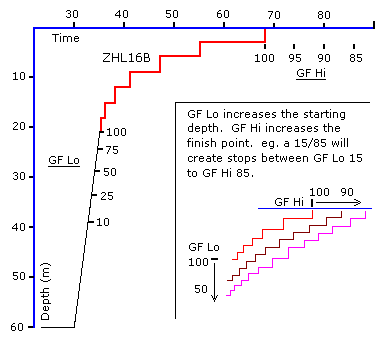- Messages
- 20,561
- Reaction score
- 14,946
- # of dives
- I'm a Fish!
@Dan_P your logic escapes me.
Dive tables that are printed for specific dive plans say "go up now"
Dive computers, at least the good ones, track your theoretical gas loading in real time and remove a huge amount of risk placed on a diver by following ratio deco. I.e. ratio deco is horrific for cave dives where you have huge multi-level profiles and you have one of two options. Run the risk of getting bent by making a math error in your head, or spend an inordinate amount of time on deco.
All of this "strategy" talk can't be incorporated into dive tables because they are printed plans. There is nothing that says you can't apply those strategies to computers that have a preprogrammed safety buffer into them *your gradient factor*
Relying on your brain to accurately calculate decompression is downright stupid when there are reliable and flexible computers on the market. If you want to employ Ratio Deco, fine, you have yet to make an argument on why you shouldn't at least run a computer to follow behind you to make sure you don't seriously mess up.
There is a damned good reason that no one uses Ratio Deco as their primary ascent strategy in cave country, doing deep hypoxic cave dives on rebreathers, or shallow easy dives on nitrox OC.
It's one thing to advocate doing it in open water with square profiles where the risk is much lower, but it's downright dangerous to advocate use as a primary decompression profile. Add to that that it takes longer than reasonable GF settings to get out of the water and was based on "how AG felt" when he got out of the water, and you have a recipe for someone to get bent. Oh wait, they already have, many times
Dive tables that are printed for specific dive plans say "go up now"
Dive computers, at least the good ones, track your theoretical gas loading in real time and remove a huge amount of risk placed on a diver by following ratio deco. I.e. ratio deco is horrific for cave dives where you have huge multi-level profiles and you have one of two options. Run the risk of getting bent by making a math error in your head, or spend an inordinate amount of time on deco.
All of this "strategy" talk can't be incorporated into dive tables because they are printed plans. There is nothing that says you can't apply those strategies to computers that have a preprogrammed safety buffer into them *your gradient factor*
Relying on your brain to accurately calculate decompression is downright stupid when there are reliable and flexible computers on the market. If you want to employ Ratio Deco, fine, you have yet to make an argument on why you shouldn't at least run a computer to follow behind you to make sure you don't seriously mess up.
There is a damned good reason that no one uses Ratio Deco as their primary ascent strategy in cave country, doing deep hypoxic cave dives on rebreathers, or shallow easy dives on nitrox OC.
It's one thing to advocate doing it in open water with square profiles where the risk is much lower, but it's downright dangerous to advocate use as a primary decompression profile. Add to that that it takes longer than reasonable GF settings to get out of the water and was based on "how AG felt" when he got out of the water, and you have a recipe for someone to get bent. Oh wait, they already have, many times





